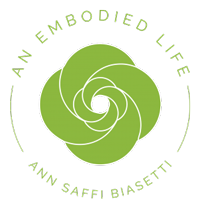I am an eating disorder specialist, specializing in the treatment and recovery from Anorexia, Binge Eating Disorder, and Bulimia as well as those on the “fringes,” such as emotional eating, body image issues, and chronic dieting and obsessional focus on health.
I also work with the following:
- Mood disturbance: Depression, anxiety, and panic disorders
- Life Transitions: Career, relationship issues, issues related to aging
- Women’s Issues: Body image, relational issues, parenting, body/life transitions such as pregnancy, post-partum depression, perimenopausal and menopause
- Spiritual Guidance: Developing and/or deepening your spiritual practice, meditation, embodiment practice and guidance
Embodied Psychotherapy- Read About Ann’s Unique Embodied Approach
What is Embodiment?
The philosopher Merleau-Ponty makes a powerful suggestion with his notion that our body is not an object, but is rather as our primary means of experiencing and communicating with the world. His notion of embodiment emphasizes the fact that we live life through the sense experiences of the body. Our bodies are the source of our experience: We come into contact with the world through the senses, and this in turn informs our way of living. Before even language and the development of intelligence, the body is our first lived experience in the world. Unfortunately, as we mature we often attempt to understand our “problems” through one area, namely the mind, rather than using all that is available to us through the body for knowledge and insight. Relying too much on thoughts and ideas can often leave us caught up in the stories of the past – and the fears of the future. If we take to heart Merleau-Ponty’s privileging of the body, then we can better attend to what we notice through our senses. In this way, we open the door not only to new information, but we also enable our mind to focus its attention more on the present. Our body offers us a vast arena of untapped knowledge and awareness that can be highly effective in creating lasting insights, yet the body is often left out of the therapy room.
Embodied Psychotherapy
Recent research has shown that long after a trauma, the body still responds as if it was a current event even though memories may have faded. Traumatic events and emotions leave an imprint in our sensory and hormonal systems and therefore, long after the event has occurred there still may be bodily sensations, reactions and feelings that continue to occur. Bessel Van Der Kolk’s research on trauma discusses the importance of engaging the body in treatment as a way to reprogram the visceral, or bodily experience that often manifests as panic attacks, hypervigilance, flashbacks, ruminating thought, and generalized anxiety and fear. Through neuroscience research we are now discovering that to have an effect on this very real visceral response we must work in increasing awareness of sensations, and ways to intervene in the moment to change up the current experience. To do this, it is imperative to work with the body and the mind as an integrated system. However, it need not be a trauma. All emotion and thoughts have a embodied connection. The more we can learn to discover what that connection is about, the more we can re-claim the body as a safe place to be, feel empowered in the moment, and allow for long-lasting insight to develop.
Throughout many years of embodiment and mindfulness training, along with studies of Buddhist philosophy and psychology, I have developed an integrative technique I call Mindfulness-Based Embodiment (MBE)™. MBE™ is based on the Four Foundations of mindfulness and honors one’s body as a primary teacher. I use a very specific verbal guide that directs a client’s attention to the awareness of their breath, then to feeling states held in the body, and to mind states held in the body. Through this process, clients become aware of the variability of sensations, feelings, and thoughts, which opens the door to the crucial teaching of the shifting nature of all phenomena. Over time less attachment is mentally formed around these states as one becomes more trusting in their ability to manage these states knowing that they will and can shift.
I use various interventions throughout a session to assist in this process of awareness. Sometimes, it is a specific practice using the breath and/or breathing techniques as the point of awareness, or a specific body grounding practice that allows one to “arrive” in the room, both in body and mind. Other times, such as when high levels of anxiety are present or very specific bodily sensations are present, such as pain, I use therapeutic restorative yoga poses, whereby the client’s body is fully supported by blankets, bolsters and blocks, specific to their anatomy. The use of therapeutic restorative poses is a powerful way to influence and change up the nervous system in the moment. These poses allow the nervous system to safely unwind while I guide them through the MBE experience. Through a calm nervous system, we allow the mind to open and process experience in a whole new way.
In an embodied psychotherapy session, the body becomes the gateway to not just in the moment presence, or mindfulness, but also compassion. I engage and acknowledge the client’s body in the room as a companion and source of great wisdom knowing that bodily sensations can offer a whole new understanding in the moment that may otherwise have gone unnoticed. Clients often come to a new present moment understanding of old issues that goes beyond just the story of the past or the one feared about the future. They are able to hold the new awareness in a compassionate way, with their nervous system in a safe, relaxed state as awareness takes place. It is through this way that their body is no longer something detached, disconnected and unknown, but rather a companion and a source of wisdom in the world.
